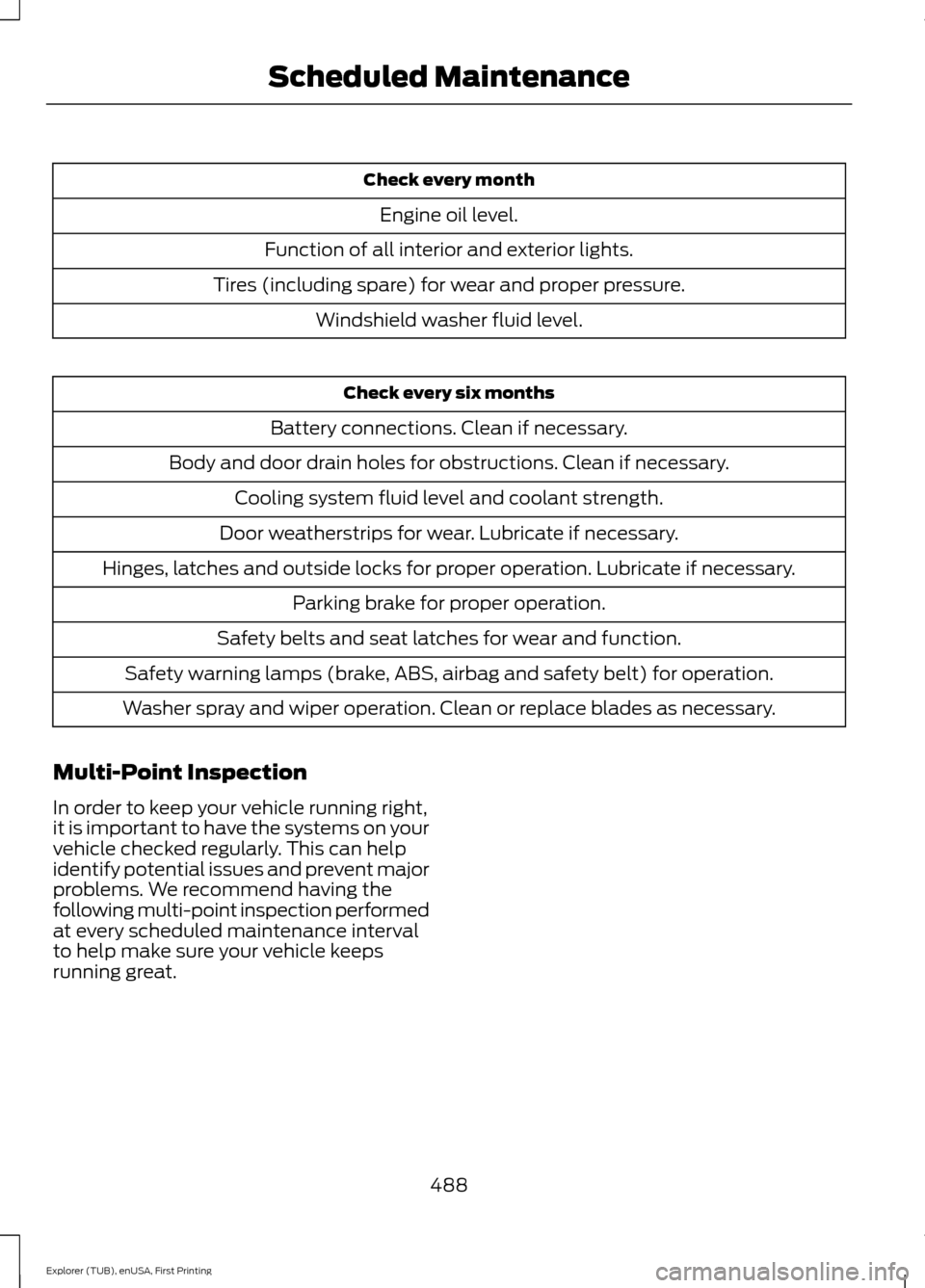2016 FORD EXPLORER interior lights
[x] Cancel search: interior lightsPage 93 of 541

The image of the approaching vehicle is
small and near the inboard edge of the
main mirror when it is at a distance. The
image becomes larger and begins to move
outboard across the main mirror as the
vehicle approaches (A). The image
transitions from the main mirror and begins
to appear in the blind spot mirror as the
vehicle approaches (B). The vehicle
transitions to your peripheral field of view
as it leaves the blind spot mirror (C).
Blind Spot Information System (If
Equipped)
See
Blind Spot Information System
(page 224). INTERIOR MIRROR WARNING
Do not adjust the mirror when your
vehicle is moving.
Note:
Do not clean the housing or glass of
any mirror with harsh abrasives, fuel or other
petroleum or ammonia-based cleaning
products.
You can adjust the interior mirror to your
preference. Some mirrors also have a
second pivot point. This lets you move the
mirror head up or down and from side to
side.
Pull the tab below the mirror toward you
to reduce glare at night.
Auto-Dimming Mirror
(If Equipped)
Note: Do not block the sensors on the front
and back of the mirror. Mirror performance
may be affected. A rear center passenger or
raised rear center head restraint may also
block light from reaching the sensor.
The mirror will dim automatically to reduce
glare when bright lights are detected from
behind your vehicle. It will automatically
return to normal reflection when you select
reverse gear to make sure you have a clear
view when backing up.
90
Explorer (TUB), enUSA, First Printing Windows and MirrorsA
B
C
E138665
Page 491 of 541

Check every month
Engine oil level.
Function of all interior and exterior lights.
Tires (including spare) for wear and proper pressure. Windshield washer fluid level. Check every six months
Battery connections. Clean if necessary.
Body and door drain holes for obstructions. Clean if necessary. Cooling system fluid level and coolant strength.
Door weatherstrips for wear. Lubricate if necessary.
Hinges, latches and outside locks for proper operation. Lubricate if necessary. Parking brake for proper operation.
Safety belts and seat latches for wear and function.
Safety warning lamps (brake, ABS, airbag and safety belt) for operation.
Washer spray and wiper operation. Clean or replace blades as necessary.
Multi-Point Inspection
In order to keep your vehicle running right,
it is important to have the systems on your
vehicle checked regularly. This can help
identify potential issues and prevent major
problems. We recommend having the
following multi-point inspection performed
at every scheduled maintenance interval
to help make sure your vehicle keeps
running great.
488
Explorer (TUB), enUSA, First Printing Scheduled Maintenance
Page 532 of 541

Cleaning the Interior...................................302
Cleaning the Windows and Wiper
Blades...........................................................302
Clearing All MyKeys.......................................56
Climate............................................................462 Climate Control Voice Commands.............465
Climate Control.............................................129
Climate Controlled Seats..........................155 Cooled Seats........................................................ 156
Coolant Check See: Engine Coolant Check............................ 282
Crash Sensors and Airbag Indicator.......46
Creating a MyKey
............................................55
Programming/Changing Configurable
Settings............................................................... 55
Cross Traffic Alert.........................................227 False Alerts........................................................... 229
Switching the System Off and On..............229
System Errors...................................................... 229
System Lights, Messages and Audible Alerts................................................................. 228
System Limitations........................................... 228
System Sensors.................................................. 228
Using the System............................................... 227
Cruise Control
..................................................74
Principle of Operation....................................... 213
Type 1........................................................................\
. 74
Type 2........................................................................\
74
Cruise control See: Using Cruise Control................................ 213
Customer Assistance................................260
D
Data Recording
..................................................9
Event Data Recording........................................... 9
Service Data Recording........................................ 9
Daytime Running Lamps
.............................82
Type 1 - Conventional
(Non-Configurable)....................................... 83
Type 2 - Configurable......................................... 83
Digital Radio
..................................................362
HD Radio Reception and Station
Troubleshooting............................................ 363
Direction Indicators
.......................................85
Driver Alert.....................................................220
PRINCIPLE OF OPERATION.......................... 220
USING DRIVER ALERT.................................... 220Driver and Passenger Airbags....................41
Children and Airbags............................................ 41
Proper Driver and Front Passenger Seating Adjustment......................................................... 41
Driving Aids
....................................................220
Driving Hints...................................................252
Driving Through Water...............................253
DRL See: Daytime Running Lamps......................... 82
E
Economical Driving
.....................................252
Emission Control System...........................177 On-Board Diagnostics (OBD-II).................... 178
Readiness for Inspection/Maintenance (I/M) Testing.................................................... 178
End User License Agreement
.................505
SYNC End User License Agreement
(EULA)............................................................. 505
Engine Block Heater....................................169 Using the Engine Block Heater...................... 170
Engine Coolant Check...............................282 Adding Engine Coolant.................................... 283
Checking the Engine Coolant........................ 282
Recycled Engine Coolant................................ 284
Severe Climates................................................. 284
What You Should Know About Fail-Safe Cooling............................................................. 284
Engine Immobilizer See: Passive Anti-Theft System..................... 70
Engine Oil Check...........................................281 Adding Engine Oil............................................... 281
Engine Oil Dipstick - 2.3L EcoBoost™..................................................281
Engine Oil Dipstick - 3.5L Duratec/3.5L Ecoboost™..................................................281
Engine Specifications - 2.3L EcoBoost™.................................................334
Drivebelt Routing............................................... 334
Engine Specifications - 3.5L Duratec.........................................................335
Drivebelt Routing............................................... 335
Engine Specifications - 3.5L Ecoboost™.................................................335
Drivebelt Routing............................................... 336
529
Explorer (TUB), enUSA, First Printing Index